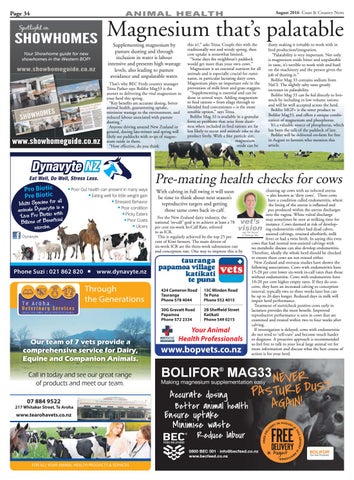Page 34
ANIMAL HEALTH
Magnesium that’s palatable Supplementing magnesium by pasture dusting and through inclusion in water is labour intensive and presents high wastage levels, also leading to pasture avoidance and unpalatable water. That’s why BEC Feeds country manager Trina Parker says Bolifor Mag33 is the answer to delivering the vital magnesium to your herd this spring. “Key benefits are accurate dosing, better animal health, guaranteeing uptake, minimise wastage to the environment, and reduced labour associated with pasture dusting.” Anyone driving around New Zealand in general, during late-winter and spring will likely see paddocks with strips of magnesium oxide in them. “How effective, do you think
this is?,” asks Trina. Couple this with the traditionally wet and windy spring, then cow uptake is somewhat limited. “Some days the neighbour’s paddock would get more than your own cows.” Magnesium is an essential nutrient for all animals and is especially crucial for ruminants, in particular lactating dairy cows. Magnesium plays an important role in the prevention of milk fever and grass staggers. “Supplementing is essential and can be done in several ways. Adding magnesium to feed rations – from silage through to blended feed concentrates – is the more sensible option,” says Trina. Bolifor Mag 33 is available in a granular form so problems that arise from dustiness when included in feed rations are far less likely to occur and animals take to the product freely. With a fine particle size, magnesium oxide can be
dusty making it irritable to work with in feed production/integration. “Palatability is very important. Not only is magnesium oxide bitter and unpalatable in taste, it’s terrible to work with and hard on the machinery and the person given the job of dusting it.” Bolifor Mag 33 contains sodium from NaCI. The slightly salty taste greatly increases its palatability. Bolifor Mag 33 can be fed directly to livestock by including in low volume rations and will be well accepted across the herd. Bolifor MGP+ is the sister product to Bolifor Mag33, and offers a unique combination of magnesium and phosphorus. It’s a valuable source of phosphorus, which has been the talk of the paddock of late. Bolifor will be delivered on-farm for free in August to farmers who mention this article.
Pre-mating health checks for cows With calving in full swing it will soon be time to think about next season’s reproductive targets and getting those same cows back in-calf. For the New Zealand dairy industry, the national ‘in-calf ’ goal is to achieve at least a 78 per cent six-week In-Calf Rate, referred to as ICR. This is regularly achieved by the top 25 per cent of Kiwi farmers. The main drivers of six-week ICR are the three-week submission rate and conception rate. One way to improve this is by
cleaning up cows with an infected uterus – also known as ‘dirty cows’. These cows have a condition called endometritis, where the lining of the uterus is inflamed and pus produced within the uterus discharges into the vagina. White vulval discharge may sometimes be seen at milking time for instance. Cows deemed at risk of developing endometritis either had dead calves, assisted calvings, retained afterbirth, milk fever or had a twin birth. In saying this even cows that had normal non-assisted calvings with no metabolic disease can also develop endometritis. Therefore, ideally the whole herd should be checked to ensure these cows are not missed either. New Zealand and overseas studies have shown the following associations. Cows with endometritis have 15-20 per cent lower six-week in-calf rates than those without endometritis. Cows with endometritis have 10-20 per cent higher empty rates. If they do conceive, they have an increased calving to conception interval, typically two to three weeks later but can be up to 26 days longer. Reduced days in milk will impair herd performance. Treatment of metricheck positive cows early in lactation provides the most benefit. Improved reproductive performance is seen in cows that are examined and treated within two to four weeks after calving. If investigation is delayed, cows with endometritis do not tend to ‘self-cure’ and become much harder to diagnose. A proactive approach is recommended so feel free to talk to your local large animal vet for more information and discuss what the best course of action is for your herd.
BOLIFOR® MAG33
0800 BEC 001 · info@becfeed.co.nz www.becfeed.co.nz
